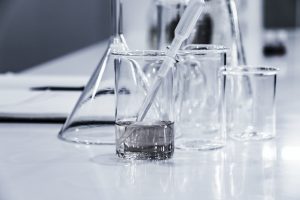| Negative Ions | + | Positive Ions | = | Solubility of compounds in water | Example |
| (Anions) | (Cations) |
| any anion | + | alkali ions | = | soluble | sodium fluoride, NaF, is soluble |
| (Li+,Na+,K+,Rb+,Cs+,Fr+) |
| any anion | + | hydrogen ion | = | soluble | sodium hydride, NaH, is soluble |
| [H+(aq)] |
| any anion | + | amonium ion | = | soluble | ammonium chloride, NH4Cl, is soluble |
| (NH4+) |
| nitrate | + | any cation | = | soluble | potassium nitrate, KNO3, is soluble |
| NO3– |
| acetate | + | any cation | = | soluble | sodium acetate, CH3COONa, is soluble |
| (CH3COO–) |
| Chloride (Cl–), Bromide (Br–), Iodide (I–) | + | silver (Ag+), lead (Pb2+), mercury (Hg2+), copper (Cu+), thallium (Tl+) | = | low solubility (insoluble) | silver chloride, AgCl, forms a white precipitate (a white solid) |
| + | any other cation | = | soluble | potassium bromide, KBr, is soluble |
| Suphate | + | calcium (Ca2+), strontium (Sr2+), barium (Ba2+), silver (Ag+), lead (Pb2+), radium (Ra2+) | = | low solubility (insoluble) | barium sulphate, BaSO4, forms a white precipitate (a white solid) |
| (SO42-) | + | any other cation | = | soluble | copper sulphate, CuSO4, is soluble |
| Sulfide | + | alkali ions (Li+,Na+,K+,Rb+,Cs+,Fr+), alkali earth metals (Be2+,Mg2+,Ca2+,Sr2+,Ba2+,Ra2+), | = | soluble | magnesium sulfide, MgS, is soluble |
| S2- | and H+(aq), NH4+ |
| + | any other cation | = | low solubility (insoluble) | zinc sulfide, ZnS, is insoluble |
| Hydroxide | + | alkali ions (Li+,Na+,K+,Rb+,Cs+,Fr+), H+(aq),NH4+,Sr2+,Ba2+,Ra2+,Tl+ | = | soluble | strontium hydroxide, |
| OH– | Sr(OH)2, is soluble |
| + | any other cation | = | low solubility (insoluble) | silver hydroxide, AgOH, is insoluble (forms a precipitate) |
| Phosphate, PO43-, Carbonate, CO32-, sulphite, SO32- | + | alkali ions (Li+,Na+,K+,Rb+,Cs+,Fr+), H+(aq),NH4+ | = | soluble | ammonium phosphate, |
| (NH4)3PO4, is soluble |
| + | any other cation | = | low solubility (insoluble) | magnesium carbonate, MgCO3, is insoluble |


